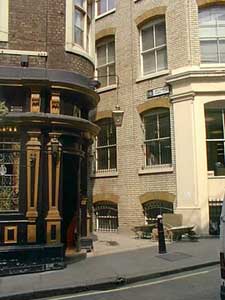|
|

Ireland Yard
Blackfriars, EC4
 When the young Shakespeare took the road from Stratford upon Avon to London, his head must have been full of plans about how he would make his fortune and become a man of property. As well as astonishing literary skills, he obviously had a fair amount of business acumen, and he managed to buy houses in both cities before he retired. When the young Shakespeare took the road from Stratford upon Avon to London, his head must have been full of plans about how he would make his fortune and become a man of property. As well as astonishing literary skills, he obviously had a fair amount of business acumen, and he managed to buy houses in both cities before he retired.
Of the few London addresses that Shakespeare was certainly associated with, Ireland Yard is by far the best documented. Now nothing more than a side street, it was then a main entrance to the vast monastery of the Black Friars. The monastery buildings had been seized and sold off during the dissolution but they were mostly left intact. The former gate house stayed in place and it was this that the playwright bought in 1613.
Shakespeare was already well established by this time. Having gone into partnership with Richard Burbage and others in their company of players, he had a stake in both the Globe and the Blackfriars theatres and took a cut of the profits. Although he is known to have lodged close to the Globe, probably near Southwark Cathedral, Shakespeare chose Blackfriars when it came to buying. Not only was the area considered select, it also seems to have been favoured by artists. Shakespeare's friend the poet and playwright Ben Jonson had a house here in about 1607 and the painter Van Dyck lived here between 1632-41.
The gate house on Ireland Yard was an ideal prospect for Shakespeare. It was a good investment and the Blackfriars Playhouse was only moments away. But the final decision to purchase may well have been forced by fate - 1613 was also the year that the Globe burnt down so the company would have had to transfer lock, stock and barrel to Blackfriars in order to keep working.
No doubt swayed by a combination of these factors, Shakespeare went on to pay £140 for the gate house. While no physical description of it survives, a deed of Conveyance for the property states that it was: ' ..now or late being in the tenure or occupancy of one William Ireland... abutting upon a street leading down to Puddle Wharf on the east part, right against the Kinges Majesties Wardrobe..' The King's Wardrobe was a department of the royal household. It is still remembered in nearby Wardrobe Place and in the name of the church of St. Andrew-By-the-Wardrobe.
Although he had been a prolific writer, Shakespeare's output seems to have slowed down shortly before he bought the Ireland Yard house. As well as being popular with the public, his plays were given special prominence in the royal court, so he probably didn't need to work so hard as he had before. It's likely that he was setting himself up for his old age and planning for the future, too. He made a point of keeping the gate house in his own title so that he could settle it on his elder daughter, Susannah, direct. Separate provisions were made for his wife, Anne.
Shakespeare died just three years after buying the property in Ireland Yard. The gate house passed to his daughter, as he intended, and she in turn passed it to her daughter, Elizabeth. Elizabeth, who was Shakespeare's last descendant, sold it on around 1667

Ireland Yard is an ordinary street. The only relic of the monastery buildings that once stood here - a small section of the wall of the Provincial's Hall - is to be found in the part of St. Ann's church yard that is still preserved here.
 Blackfriars (District & Circle lines) Blackfriars (District & Circle lines)
Copyright © Jan Collie 2002
Published by permission of the author.
All rights reserved. No reproduction, copy or transmission of this publication may be made without written permission.
|
|